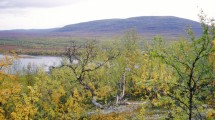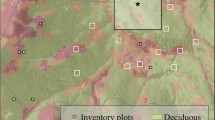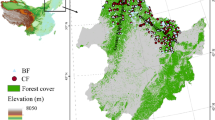Abstract
Background
Weather conditions and fungal morphology may influence spatial and temporal dynamics of carbon transfer to ectomycorrhizal fungi from their tree hosts but field studies of these dynamics are challenging.
Methods
Broad-leaved trees in a Swiss forest were labeled with 13C-depleted CO2 from 2001–2005 and 13C traced into ectomycorrhizal sporocarps collected at different distances from those trees. We then correlated distance (zone), year, fungal genus, fungal morphology, and solar radiation against sporocarp δ13C and loge C/N in stepwise regressions.
Results
CO2-supplied trees contributed 71 ± 5%, 32 ± 6%, and 19 ± 7% of sporocarp carbon at 0–6, 6–12, and 12–18 m from these trees, respectively. Fungal morphology (rhizomorph presence and ectomycorrhizae hydrophobicity) was uncorrelated with fungal carbon acquisition. After drought in 2003, CO2-supplied trees contributed less carbon in 2004 than in other years to sporocarps and sporocarp loge C/N decreased. In contrast, sporocarp loge C/N peaked in 2005 and contributions from CO2-labeled trees to the 6–12 and 12–18 m zones increased. Solar radiation with a 14–21 day lag correlated negatively with loge C/N. Sporocarp loge C/N correlated positively with δ13C at 0–6 m and negatively elsewhere.
Conclusions
These patterns indicated: 1) fungal morphology did not affect carbon transfers, 2) carbohydrates rather than amino acids were transferred across zones to sporocarps (inferred from spatial correlations of loge C/N and δ13C), 3) sporocarp δ13C and loge C/N reflected the last 2–3 weeks of photosynthesis; 4) summer drought and plant allocation influenced the quantity and spatial extent of belowground transfer.






Similar content being viewed by others
Data Availability
Data for the study are archived at Mendeley Data, https://doi.org/10.17632/yzcm5vmxf8.1.
Code availability
Not applicable.
Change history
23 October 2023
A Correction to this paper has been published: https://doi.org/10.1007/s11104-023-06356-1
References
Agerer R (2001) Exploration types of ectomycorrhizae - A proposal to classify ectomycorrhizal mycelial systems according to their patterns of differentiation and putative ecological importance. Mycorrhiza 11:107–114
Agerer R (2006) Fungal relationships and structural identity of their ectomycorrhizae. Mycol Prog 5(2):67–107
Bader MKF, Leuzinger S, Keel SG, Siegwolf RT, Hagedorn F, Schleppi P, Körner C (2013) Central European hardwood trees in a high-CO2 future: synthesis of an 8-year forest canopy CO2 enrichment project. J Ecol 101(6):1509–1519
Breitenbach J, Kränzlin F (1981) Pilze der Schweiz. Mycologia, Lucerne
Cavin L, Jump AS (2017) Highest drought sensitivity and lowest resistance to growth suppression are found in the range core of the tree Fagus sylvatica L. not the equatorial range edge. Global Change Biol 23(1):362–379
Ciais P, Reichstein M, Viovy N, Granier A, Ogée J, Allard V, Aubinet M, Buchmann N, Bernhofer C, Carrara A (2005) Europe-wide reduction in primary productivity caused by the heat and drought in 2003. Nature 437(7058):529–533
De la Varga H, Águeda B, Ágreda T, Martínez-Peña F, Parladé J, Pera J (2013) Seasonal dynamics of Boletus edulis and Lactarius deliciosus extraradical mycelium in pine forests of central Spain. Mycorrhiza 23(5):391–402
Deslippe JR, Hartmann M, Grayston SJ, Simard SW, Mohn WW (2016) Stable isotope probing implicates a species of Cortinarius in carbon transfer through ectomycorrhizal fungal mycelial networks in Arctic tundra. New Phytol 210(2):383–390
Du C, Wang X, Zhang M, Jing J, Gao Y (2019) Effects of elevated CO2 on plant C-N-P stoichiometry in terrestrial ecosystems: A meta-analysis. Sci Total Environ 650:697–708
Fujihara S, Kasuga A, Aoyagi Y, Sugahara T (1995) Nitrogen-to-protein conversion factors for some common edible mushrooms. J Food Sci 60(5):1045–1047
Göttlicher SG, Taylor AFS, Grip H, Högberg MN, Betson NR, Valinger E, Högberg P (2008) The lateral spread of tree root systems in boreal forests: Estimates based on 15N uptake and distribution of sporocarps of ectomycorrhizal fungi. Forest Ecol Manage 255:75–81
Graf A, Klosterhalfen A, Arriga N, Bernhofer C, Bogena H, Bornet F, Brüggemann N, Brümmer C, Buchmann N, Chi J (2020) Altered energy partitioning across terrestrial ecosystems in the European drought year 2018. Philos Trans R Soc B 375(1810):20190524
Hacket-Pain AJ, Lageard JG, Thomas PA (2017) Drought and reproductive effort interact to control growth of a temperate broadleaved tree species (Fagus sylvatica). Tree Physiol 37(6):744–754
Hasselquist NJ, Metcalfe DB, Inselsbacher E, Stangl Z, Oren R, Näsholm T, Högberg P (2016) Greater carbon allocation to mycorrhizal fungi reduces tree nitrogen uptake in a boreal forest. Ecol 97(4):1012–1022
Hobbie EA, Agerer R (2010) Nitrogen isotopes in ectomycorrhizal sporocarps correspond to belowground exploration types. Plant Soil 327(1):71–83
Hobbie EA, Sánchez FS, Rygiewicz PT (2012) Controls of isotopic patterns in saprotrophic and ectomycorrhizal fungi. Soil Biol Biochem 48(1):60–68
Hobbie EA, Hofmockel KS, van Diepen LT, Lilleskov EA, Ouimette AP, Finzi AC (2014) Fungal carbon sources in a pine forest: evidence from a 13C-labeled global change experiment. Fungal Ecol 10:91–100
Hobbie EA, Grandy AS, Harmon ME (2020) Isotopic and compositional evidence for carbon and nitrogen dynamics during wood decomposition by saprotrophic fungi. Fungal Ecol 45:100915
Hobbie EA, Bendiksen K, Thorp NR, Ohenoja E, Ouimette AP (2021) Climate records, isotopes, and C: N stoichiometry reveal carbon and nitrogen flux dynamics differ between functional groups of ectomycorrhizal fungi. Ecosystems 25(5):1207–1217
Högberg MN, Briones MJ, Keel SG, Metcalfe DB, Campbell C, Midwood AJ, Thornton B, Hurry V, Linder S, Näsholm T (2010) Quantification of effects of season and nitrogen supply on tree below-ground carbon transfer to ectomycorrhizal fungi and other soil organisms in a boreal pine forest. New Phytol 187(2):485–493
Jörgensen K, Clemmensen KE, Wallander H, Lindahl BD (2023) Do ectomycorrhizal exploration types reflect mycelial foraging strategies? New Phytol 237(2):576–584
Keel SG, Siegwolf RTW, Körner C (2006) Canopy CO2 enrichment permits tracing the fate of recently assimilated carbon in a mature deciduous forest. New Phytol 172(2):319–329
Klein T, Siegwolf RT, Körner C (2016) Belowground carbon trade among tall trees in a temperate forest. Sci 352(6283):342–344
Körner C, Asshoff R, Bignucolo O, Hättenschwiler S, Keel SG, Peláez-Riedl S, Pepin S, Siegwolf RT, Zotz G (2005) Carbon flux and growth in mature deciduous forest trees exposed to elevated CO2. Sci 309(5739):1360–1362
Lamhamedi MS, Godbout C, Fortin JA (1994) Dependence of Laccaria bicolor basidiome development on current photosynthesis of Pinusstrobus seedlings. Can J for Res 24(9):1797–1804
Leuzinger S, Zotz G, Asshoff R, Körner C (2005) Responses of deciduous forest trees to severe drought in Central Europe. Tree Physiol 25(6):641–650
Lilleskov EA, Kuyper TW, Bidartondo MI, Hobbie EA (2019) Atmospheric nitrogen deposition impacts on the structure and function of forest mycorrhizal communities: a review. Environ Pollut 246:148–162
Meinen C, Leuschner C, Ryan NT, Hertel D (2009) No evidence of spatial root system segregation and elevated fine root biomass in multi-species temperate broad-leaved forests. Trees 23(5):941–950
Mildner M, Bader MK-F, Leuzinger S, Siegwolf RT, Körner C (2014) Long-term 13C labeling provides evidence for temporal and spatial carbon allocation patterns in mature Picea abies. Oecologia 175(3):747–762
Molina R (1992) Specificity phenomena in mycorrhizal symbioses: Community-ecological consequences and practical implications. In: Molina R, Massicotte H, Trappe JM (eds) Mycorrhizal functioning: An integrative plant-fungal process. Springer, New York, pp 357–423
Nara K (2015) The role of ectomycorrhizal networks in seedling establishment and primary succession. Horton, TR. Springer, Mycorrhizal Networks, pp 177–201
Pepin S, Körner C (2002) Web-FACE: a new canopy free-air CO2 enrichment system for tall trees in mature forests. Oecologia 133(1):1–9
Pollierer MM, Scheu S, Tiunov AV (2020) Isotope analyses of amino acids in fungi and fungal feeding Diptera larvae allow differentiating ectomycorrhizal and saprotrophic fungi-based food chains. Funct Ecol 34(11):2375–2388
Prescott CE, Grayston SJ, Helmisaari H-S, Kaštovská E, Körner C, Lambers H, Meier IC, Millard P, Ostonen I (2020) Surplus carbon drives allocation and plant–soil interactions. Trends Ecol Evol 35:1110–1117
Rinaldi AC, Comandini O, Kuyper TW (2008) Ectomycorrhizal fungal diversity: separating the wheat from the chaff. Fungal Diversity 33:1–45
Rog I, Rosenstock NP, Körner C, Klein T (2020) Share the wealth: Trees with greater ectomycorrhizal species overlap share more carbon. Mol Ecol 29(13):2321–2333
Savoie J-M, Largeteau ML (2011) Production of edible mushrooms in forests: trends in development of a mycosilviculture. Appl Microbiol Biotechnol 89(4):971–979
Steinmann K, Siegwolf RT, Saurer M, Körner C (2004) Carbon fluxes to the soil in a mature temperate forest assessed by 13 C isotope tracing. Oecologia 141(3):489–501
Weigt RB, Raidl S, Verma R, Agerer R (2012) Exploration type-specific standard values of extramatrical mycelium - a step towards quantifying ectomycorrhizal space occupation and biomass in natural soil. Mycol Prog 11(1):287–297
Acknowledgements
The CO2 enrichment experiment was funded by the Swiss National Science Foundation projects 3100-059769.99, 3100-067775.02 and 5005-65755 (NCCR Climate), and the Swiss Canopy Crane by the Swiss Agency for the Environment, Forest and Landscape. A grant from the US National Science Foundation (DEB-1146328) also supported this work, as did support from Fulbright Austria. We thank Nick Rosenstock, Talia Michaud, and Anna Polyakov for helpful suggestions on the manuscript.
Funding
None.
Author information
Authors and Affiliations
Contributions
CK, MS, and RS planned and designed the research. SGK, and KS performed experiments and conducted fieldwork, MW identified fungal species, MW and EAH assigned fungal associations, EAH analyzed the data, all authors wrote the manuscript.
Corresponding author
Ethics declarations
Conflicts of interest
The authors declare no conflicts of interest in this work.
Ethics Approval
This article does not contain any studies with human participants or animals performed by any of the authors.
Consent to participate
Not applicable.
Consent for publication
Not applicable.
Additional information
Responsible Editor: Xinhua He.
Publisher's Note
Springer Nature remains neutral with regard to jurisdictional claims in published maps and institutional affiliations.
Author Contributions: RS, CK, and MS conceived and designed the experiments. KS SGK, and MS conducted fieldwork, MW identified sporocarps, EAH analyzed the data and wrote the manuscript; all authors provided editorial advice.
Supplementary Information
Below is the link to the electronic supplementary material.
Rights and permissions
Springer Nature or its licensor (e.g. a society or other partner) holds exclusive rights to this article under a publishing agreement with the author(s) or other rightsholder(s); author self-archiving of the accepted manuscript version of this article is solely governed by the terms of such publishing agreement and applicable law.
About this article
Cite this article
Hobbie, E.A., Siegwolf, R., Körner, C. et al. Weather modifies the spatial extent of carbohydrate transfers from CO2-supplied broad-leaved trees to ectomycorrhizal fungi. Plant Soil 494, 717–730 (2024). https://doi.org/10.1007/s11104-023-06314-x
Received:
Accepted:
Published:
Issue Date:
DOI: https://doi.org/10.1007/s11104-023-06314-x




